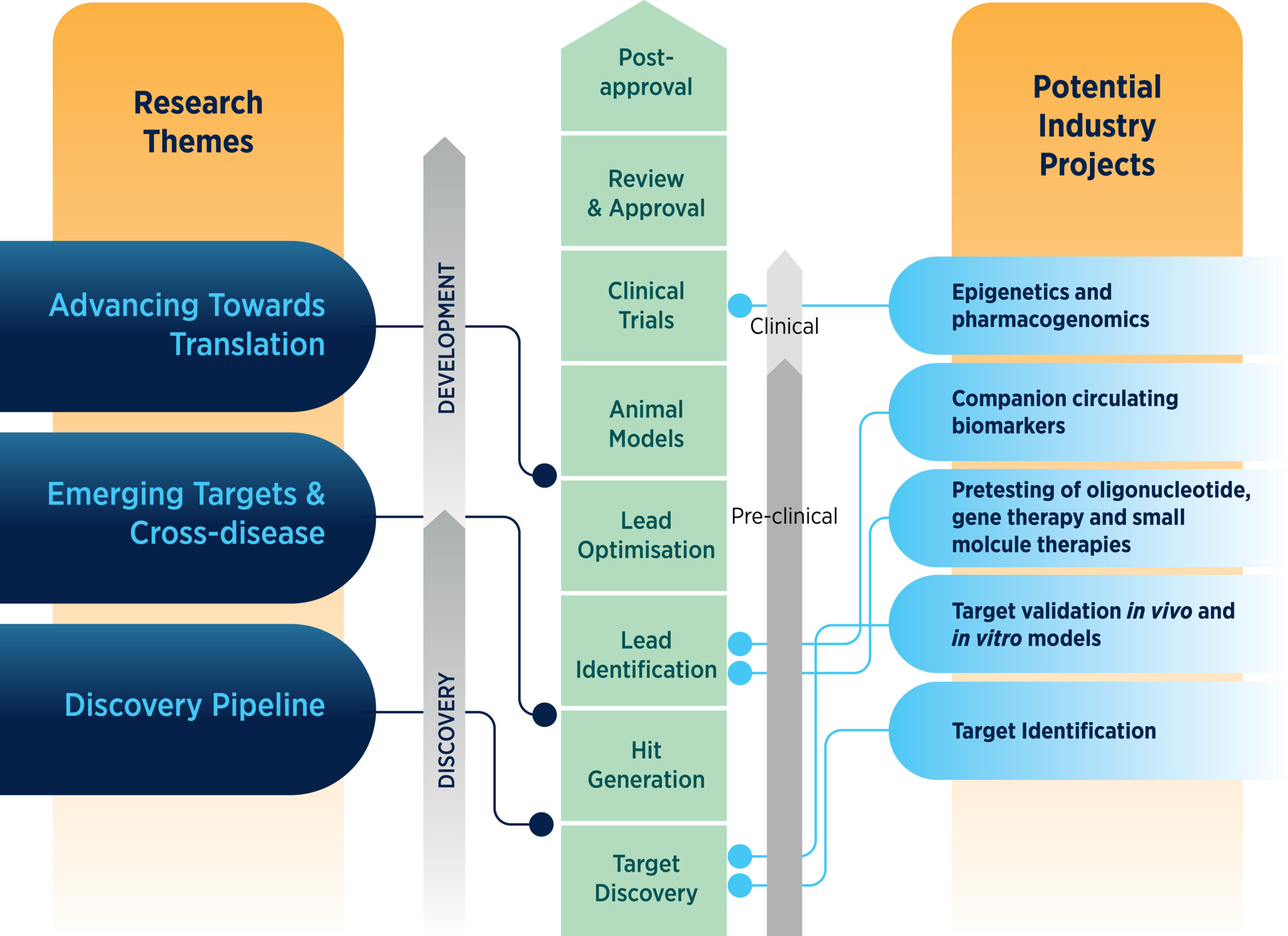Welcome to our Therapeutics research programme where our objective is to produce a new generation of disease-modifying treatments for brain diseases. We perform state-of-the-art research into the causes of brain disease, focusing on noncoding RNAs, metabolic and epigenetic processes, the blood brain barrier and neuroinflammation using technologies including super-resolution imaging, single cell ‘omics and neurophysiology. We then evaluate new gene and drug candidates through our range of cell, animal and human models to gain proof-of-concept efficacy and understand mechanism of action. Finally, we advance the most promising leads into preclinical development, often in collaboration with industry partners.
Our Grand Challenges are
- Grow our pipeline of innovative drug candidates that target noncoding RNAs, blood-brain barrier (BBB), inflammation and metabolism.
- Use single cell ‘omics, neurophysiology, imaging and data science to explain disease-modifying actions.
- Connect immunology to neurology/neuropsychiatry, exploring immune regulators as therapeutic targets and biomarker signals.
- Develop methods to achieve safer therapy delivery to the CNS, including to specific cell types and over different time-frames.
- Increase the number of clinical trials of innovative therapies for brain diseases in Ireland.
Overview of the Therapeutics Research Programme

View Transcript
ShowOur Therapeutics Research Programme brings scientific discoveries from pre-clinical stage through to clinical trials. We also work with industry partners on mutual research interests.
Our Therapeutics Programme is distinguished by
- World-leading expertise in targeting noncoding RNAs, BBB function, inflammation and metabolism using ASOs, AAV- and small molecule drugs.
- In vivo preclinical testing and human models (patient iPSCs, human brain tissue and biofluids) for the epilepsies, ALS, MS, psychosis and TBI.
- Flexible industry-ready platforms for early-stage screening using imaging- and neurophysiology-based assessments.
- Emerging strengths in therapies that deliver cell type targeting, spatial and age-span adjusted release.
- Trial-ready clinical networks.
Advancing therapies toward translation
We are looking at therapies that are closest to preclinical development. This includes an oligonucleotide drug that targets a microRNA, a gene therapy to restore the blood-brain barrier, and a drug that targets a receptor cells use to sense damage and trigger inflammation. Experiments will be testing these promising therapies in preclinical and human models, measuring how the activity of neuronal networks change upon their introduction, and understanding how gene activity adapts in specific cell types in the brain. We will also explore how to safely deliver the therapies to the brain and look at whether biofluids and immune cells contain signals (biomarkers) that can predict effectiveness.
Research Leads
Emerging and cross-disease targets
We are looking at some of our more recently discovered targets. This includes transfer RNA fragments, enzymes that act on RNA, processes controlling energy balance and genes that regulate circadian cycles. Experiments will pick suitable small molecule or genetic approaches to test the effects of modulating these targets in appropriate models. We will be looking at whether they improve primary disease symptoms (e.g. better control of seizures) and keep an eye on potential secondary benefits (e.g. improved cognition). We think some of these drugs could work in diseases they were not originally intended for, and here we take advantage of an extensive preclinical network to test in other models. Finally, experiments will be exploring whether the time when a drug is given affects its performance and incorporating molecular switches that allow us to control and for how long a gene therapy is active after delivery.
Research Leads
New targets pipeline
In this part of the programme, we conduct early screening for new targets. We begin by mining our large datasets on gene activity in health and disease and use mathematical models and bioinformatics approaches to search for new targets. We will perform screens of novel small molecular libraries for any compounds that can return hyper-excitable or dysfunctional neurons to basal states. Last, we are using a large-scale gene editing technology to systematically knockdown genes that encode RNA regulatory molecules. Upon passing this stage, targets will be selected and proceed through the above set of workstreams.
Research Leads
Key Therapeutics Publications
5′ValCAC tRNA fragment generated as part of a protective angiogenin response provides prognostic value in amyotrophic lateral sclerosis
3D Fabrication and Characterisation of Electrically Receptive PCL-Graphene Scaffolds for Bioengineered In Vitro Tissue Models
A loss of function mutation in CLDN25 causing Pelizaeus-Merzbacher-like leukodystrophy
Collaborative Industry Projects
We partner with industry to address the key challenges in diagnosing neurological disease.
Read more about Industry Partnerships.
Our Industry Partners
Roche
We are working together to develop new RNA-based treatments for childhood epilepsies and neuro-developmental diseases.
Janssen
We are working together to reduce neuroinflammation in regions of the brain associated with triggering seizures.
Neumirna SpA
We are working together to explore potential disease-modifying interventions for temporal lobe epilepsy.
STORM Therapeutics
We are working together to explore the role of RNA epigenetics in epilepsy.

Diagnostics
The objective of the diagnostics programme is to create a stratified, research-engaged patient population to enable faster diagnosis, precision medicine and clinical trials. Our research focuses on how changes in our genes can cause, or contribute to the development of neurological disease.
Digital Health
Welcome to our Digital Health Research Programme, where we are dedicated to transforming and democratising healthcare through a more holistic and comprehensive approach to individual health and wellbeing.










